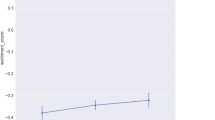Abstract
An auction platform is a dynamic environment where a rich variety of social effects can be observed. Most of those effects remain unnoticed or even hidden to ordinary users. The in-depth studies of such effects should allow us to identify and understand the key factors influencing users’ behaviour. The material collected from the biggest Polish auction house has been analyzed. NLP algorithms were applied to extract sentiment-related content from collected comments and to measure informativity. Emotional distance between negative, neutral and positive comments has been calculated. The obtained results confirm the existence of the spiral-of-hatred effect but also indicate that much more complex patterns of mutual relations between sellers and buyers exist. The last section contains a several suggestions which can prove useful to improve trustworthiness of users’ reports and security of an auction platform in general.
Similar content being viewed by others
References
Baayen, H. (2001). Word frequency distributions. Berlin: Springer.
Bajari, P., & Hortacsu, A. (1999). Winner’s curse, reserve prices and endogenous entry: empirical insights from eBay auctions. Stanford Institute for Economic Policy Research. SIEPR. Policy paper No. 99-23.
Botsch, J., & Luckner, S. (2008). Empirische Analyse von Bewertungskommentaren des Reputationssystems von eBay. Multikonferenz Wirtschaftsinformatik [DBLP:conf/mkwi/BotschL08].
Buczynski, A., & Przepiorkowski, A. (2008). Demo: an open source tool for partial parsing and morphosyntactic disambiguation. In Proceedings of LREC 2008.
Buczynski, A., & Wawer, A. (2008). Shallow parsing in sentiment analysis of product reviews. In Proceedings of the partial parsing workshop at LREC 2008 (pp. 14–18).
Friedman, E. J., & Resnick, P. (2001). The social cost of cheap pseudonyms. Journal of Economics and Management Strategy, 10, 173–199.
Ganesan, K. A., Sundaresan, N., & Deo, H. (2008). Mining tag clouds and emoticons behind community feedback. In Proceeding of the 17th international conference on World Wide Web. WWW ’08, Beijing, China, April 21–25, 2008. New York: ACM.
Gregg, D. G., & Scott, J. (2008). A typology of complaints about eBay sellers. Communications of the ACM, 51(4).
Khopkar, T., Li, X., & Resnick, P. (2005). Self-selection, slipping, salvaging, slacking, and stoning: the impacts of negative feedback at eBay. In ACM conference on electronic commerce 2005 (pp. 223–231) [DBLP:conf/sigecom/KhopkarLR05].
Kleinberg, J. (2008). The convergence of social and technological networks. Communication of ACM, 51(11), 66–72.
Lee, Z., Im, I., & Lee, S. J. (2000). The effect of negative buyer feedback on prices in Internet auction markets. In W. Orlikowski et al. (Eds.), The proceedings of the 21st international conference on information systems (pp. 286–287).
Lin, Z., & Li, J. (2005). The online auction market in China: a comparative study between Taobao and eBay. In ICEC 2005 (pp. 123–129).
Lucking-Reiley, D., Bryan, D., Prasa, N., & Reeves, D. (1999). Pennies from eBay: the determinants of price in online auctio ns. http://eller.arizona.edu/~reiley/papers/PenniesFromEBay.pdf.
Morzy, M., & Wierzbicki, A. (2006). The Sound of Silence: Mining implicit feedbacks to compute reputation. In WINE 2006 (pp. 365–376).
Nam sued for libel over comments on eBay. http://www.telegraph.co.uk/news/uknews/3247683/Man-sued-for-libel-over-comments-on-eBay.html.
Philip, J., et al. (1966). The general inquirer: a computer approach to content analysis. Cambridge: The MIT Press.
Scheff, T., & Fearon, D. Jr. (2004). Social and emotional components in self-esteem. Journal of the Theory of Social Behavior, 34, 73–90.
Standifird, S. S. (2001). Reputation and E-commerce: eBay auctions and the asymmetrical impact of positive and negative ratings. Journal of Management, 27(3), 279–295.
Talwar, A., Jurca, R., & Faltings, B. (2007). Understanding user behavior in online feedback reporting. In Proceedings of the 8th ACM conference on electronic commerce, EC ’07 (pp. 134–142). New York: ACM.
Wawer, A., & Nielek, R. (2008). Application of automated sentiment extraction from text to modeling of public opinion dynamics. Polish Journal of Environmental Studies, 17(3B), 508–513 (ISSN 1230-1485).
Wydra, H. (2008). The recurrence of violence. Sociology Compass, 2(1), 183–194.
Author information
Authors and Affiliations
Corresponding author
Additional information
This research has been supported by the Polish Ministry of Science grant N N516 4307 33.
A. Wierzbicki has been supported by the grant of the Polish Ministry of Science 69/N-SINGAPUR/2007/0.
Rights and permissions
About this article
Cite this article
Nielek, R., Wawer, A. & Wierzbicki, A. Spiral of hatred: social effects in Internet auctions. Between informativity and emotion. Electron Commer Res 10, 313–330 (2010). https://doi.org/10.1007/s10660-010-9058-9
Published:
Issue Date:
DOI: https://doi.org/10.1007/s10660-010-9058-9




